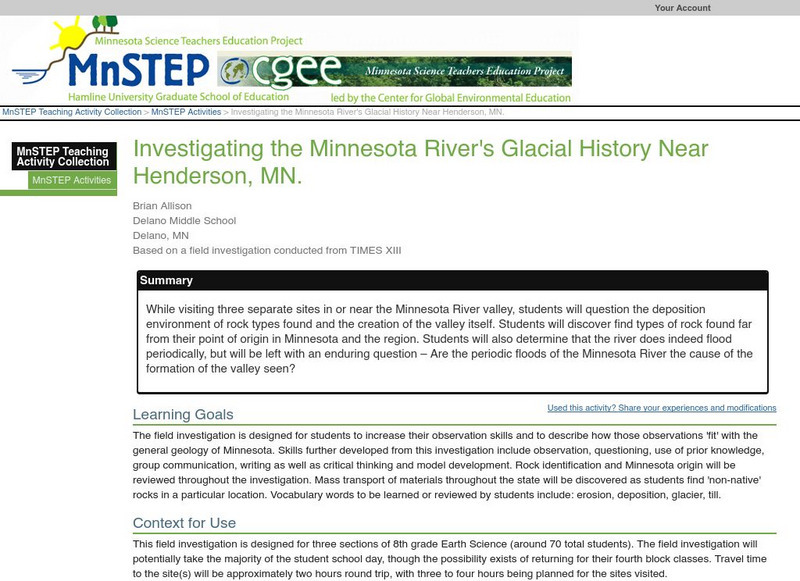Hi, what do you want to do?
Curated OER
Dark and Beautiful Caves
Students research how caves form. They describe the major stone formations in caves by taking notes. They construct a clay model of a cave and mark each formation making it easy to identify in the legend.
Curated OER
River Planning
Students use a model to conduct an experiment involving dam construction. Based on their observations, they draw conclusions about social, economic, and and environmental issues and make a decision concerning dam location. As a group,...
Curated OER
The Grand Canyon
Students act as scientists investigating the damming and experimental flooding of the Colorado River by the Glen Canyon dam that took place in 1996. They write a proposal as to whether or not more experimental flooding should be done on...
Curated OER
Red River of the North Flooding 1997
Learners describe factors that affect the flow of rivers and explain their relationships. They research the factors involved in flooding events. describe the effects of present and future practices in land use, and river control methods.
Curated OER
Arkansas and Louisiana Purchase Wetlands
Students experiment to determine the value and importance of wetlands in Arkansas. They develop an environmental appreciation for wetlands.
Curated OER
Oceans: A Sensory Haiku
Students create an ocean haiku. In this haiku instructional activity, students use their five senses to write a haiku. Students watch videos about the ocean, make a sensory portrait, and create a class haiku.
Curated OER
Soil Runoff Challenge
Students find ways to decrease soil runoff for an African Village as a part of a Peace Corps project. In this soil runoff lesson, students play a soil runoff challenge online. Students complete online activities and view a slide show to...
Curated OER
Nature Rules In The Great Flood of 1993
Students examine the event of the Great Flood of 1993. Using the internet, they research the economic, social and ecological changes that impacted the area. They conduct a town meeting in which they debate the positives and negatives of...
Curated OER
Coasts
Students explain the different types of marine coasts and where they are located in the United States and its territories. They explain and identify some of the life forms that inhabit different marine coastal regions.
Curated OER
Geologic History of Long Island Sound
For this geologic history of Long Island Sound worksheet, students read about how the Long Island sound was formed through rivers and glaciers advancing and retreating. Students answer 5 questions about the reading and the formation of...
Curated OER
A World in a Grain of Sand
Students go exploring Britain's beaches. In this geography lesson, students visit selected websites to learn about specific beach habitats and the history of cleaning those beaches.
Curated OER
Snapshot Day Definitions & Activities
In this watershed worksheet, students read through related definitions and complete 17 short answer questions about deposition and erosion in the Hudson River.
Curated OER
THE TRICKLE DOWN EFFECT
Students participate in an exercise which demonstrates how sediments are deposited.
Curated OER
Layers of Time in the Earth
Learners are introduced to the concept of stratification as a historical and geological process. Students will read about the Richard Beene archaeological site, which lies near San Antonio, Texas on the Medina River, and watch a short...
Curated OER
Sedimentation
Students are introduced to the various types of sedimentation. In groups, they define the term and research what causes it to happen. They compare and contrast the different types of sedimentation and research how it occurs off of Cape...
Curated OER
Law of Superposition
Students identify the law of superposition and it states that beds of rock in a series are laid down with the oldest at the bottom and younger layers on the top. They construct a legen for a block diagram and construct a block diagram...
Curated OER
Let's Go! Virtual Yellowstone Tour
Students research the geologic wonders of Yellowstone National Park. They locate the main geologic features of Yellowstone on a map of the park. Students write a description of the geologic features to be included on the map for a...
Curated OER
"The Site Every American Should See"
Students research the natural wonders of the Grand Canyon. They write a descriptive paper about the Park. They also write a speech about why the Grand Canyon should be preserved.
CK-12 Foundation
Ck 12: Earth Science: Landforms From Stream Erosion and Deposition
[Free Registration/Login may be required to access all resource tools.] Explains how and where rivers erode and deposit sediments, including particles and dissolved ions.
CK-12 Foundation
Ck 12: Fourth Grade: Earth Science: Erosion and Deposition by Flowing Water
[Free Registration/Login may be required to access all resource tools.] Discusses how flowing water causes erosion; describes how runoff, streams, and rivers change Earth's surface; and identifies features caused by groundwater erosion.
Other
Virtual Courseware Project: Geology Labs on Line: Virtual River
Learn about river processes like discharge, flooding, flood frequency, erosion, and deposition in this interactive tutorial. Tutorial includes interactive exercises and assessments.
Science Education Resource Center at Carleton College
Serc: Investigating the Minnesota River's Glacial History Near Henderson, Mn.
While visiting three separate sites in or near the Minnesota River valley, young scholars will question the deposition environment of rock types found and the creation of the valley itself. Students will discover find types of rock found...
Science Education Resource Center at Carleton College
Serc: Investigation Erosion in Our World
In this lab activity, students will look for evidence of erosion in river or streams. This activity should take place after students have observed erosion in a model.
National Association of Geoscience Teachers
Nagt: Variable Rivers
In this lesson learners will be introduced to rivers and river processes. They will test an isolated variable in rivers and they will test either the amount of water, velocity of water, or steepness of the river bed to determine how...




























